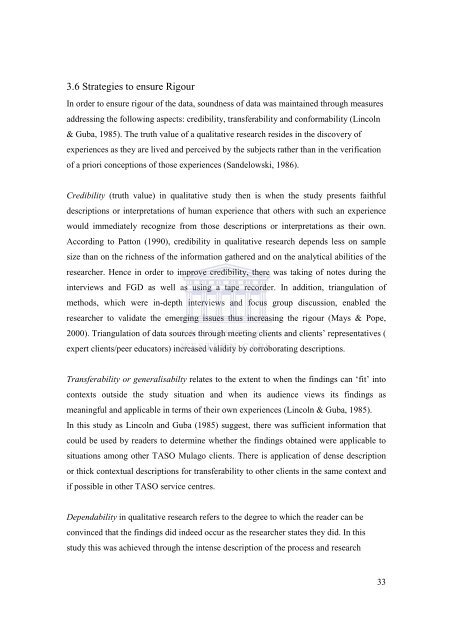Disclosure of Hiv status to sexual partners among people who ...
Disclosure of Hiv status to sexual partners among people who ...
Disclosure of Hiv status to sexual partners among people who ...
You also want an ePaper? Increase the reach of your titles
YUMPU automatically turns print PDFs into web optimized ePapers that Google loves.
3.6 Strategies <strong>to</strong> ensure Rigour<br />
In order <strong>to</strong> ensure rigour <strong>of</strong> the data, soundness <strong>of</strong> data was maintained through measures<br />
addressing the following aspects: credibility, transferability and conformability (Lincoln<br />
& Guba, 1985). The truth value <strong>of</strong> a qualitative research resides in the discovery <strong>of</strong><br />
experiences as they are lived and perceived by the subjects rather than in the verification<br />
<strong>of</strong> a priori conceptions <strong>of</strong> those experiences (Sandelowski, 1986).<br />
Credibility (truth value) in qualitative study then is when the study presents faithful<br />
descriptions or interpretations <strong>of</strong> human experience that others with such an experience<br />
would immediately recognize from those descriptions or interpretations as their own.<br />
According <strong>to</strong> Pat<strong>to</strong>n (1990), credibility in qualitative research depends less on sample<br />
size than on the richness <strong>of</strong> the information gathered and on the analytical abilities <strong>of</strong> the<br />
researcher. Hence in order <strong>to</strong> improve credibility, there was taking <strong>of</strong> notes during the<br />
interviews and FGD as well as using a tape recorder. In addition, triangulation <strong>of</strong><br />
methods, which were in-depth interviews and focus group discussion, enabled the<br />
researcher <strong>to</strong> validate the emerging issues thus increasing the rigour (Mays & Pope,<br />
2000). Triangulation <strong>of</strong> data sources through meeting clients and clients’ representatives (<br />
expert clients/peer educa<strong>to</strong>rs) increased validity by corroborating descriptions.<br />
Transferability or generalisabilty relates <strong>to</strong> the extent <strong>to</strong> when the findings can ‘fit’ in<strong>to</strong><br />
contexts outside the study situation and when its audience views its findings as<br />
meaningful and applicable in terms <strong>of</strong> their own experiences (Lincoln & Guba, 1985).<br />
In this study as Lincoln and Guba (1985) suggest, there was sufficient information that<br />
could be used by readers <strong>to</strong> determine whether the findings obtained were applicable <strong>to</strong><br />
situations <strong>among</strong> other TASO Mulago clients. There is application <strong>of</strong> dense description<br />
or thick contextual descriptions for transferability <strong>to</strong> other clients in the same context and<br />
if possible in other TASO service centres.<br />
Dependability in qualitative research refers <strong>to</strong> the degree <strong>to</strong> which the reader can be<br />
convinced that the findings did indeed occur as the researcher states they did. In this<br />
study this was achieved through the intense description <strong>of</strong> the process and research<br />
33
















